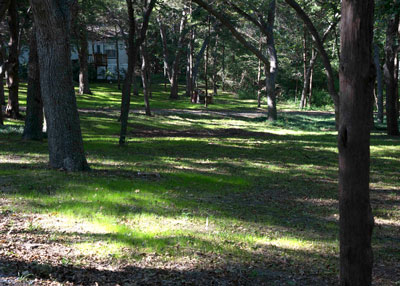If You Have Ryegrass
We live in rural Collin County (northeast of Dallas). It’s not uncommon to have rain in late fall and early spring, and that can make for very muddy conditions. I’ve been sowing ryegrass for the past 30 winters to give our dogs and cats (and me!) something solid to walk on.
This area gets almost no sunlight. It’s the ground floor of a pecan forest, and because it’s so shady, normal grasses like bermuda and St. Augustine won’t grow here. If it weren’t for the mud, I probably wouldn’t care. But the pecans drop their leaves and winter rye will thrive here from now until May.

Photo: It’s amazing how quickly ryegrass seeds sprout. Where I’ve overseeded permanent turf elsewhere in our landscape it’s just starting to show. Soon it will look as verdant as this does.
We planted this ryegrass eight days ago. I actually took the photo on the sixth day. We watered lightly the day it was planted and then a slow, soaking rain rolled through last weekend. Odds are that I won’t water it again. Fall and winter rains may be sufficient.
So assuming I won’t be watering again, what care does it need? I can boil it down to three things:
• Mow it regularly. Left unmowed, ryegrass quickly grows spindly. Our mower is set to 2 inches.
• Fertilize it in late October or early November. I’ll use the same high-nitrogen or all-nitrogen lawn food I apply to other parts of my landscape during its growing season.
• Keep leaves picked up. Tree leaves pack and form an impenetrable layer like an old-fashioned thatch roof. That encourages disease, and prevents the ryegrass from making strong clumps.
If you’re interested in planting ryegrass yourself, get the job done right away. It requires fall warmth to grow and fill in, so don’t delay any more. “Perennial” rye costs more, but it’s a lot easier to maintain. It gives faster, more uniform germination and it requires about one-third as much mowing.
